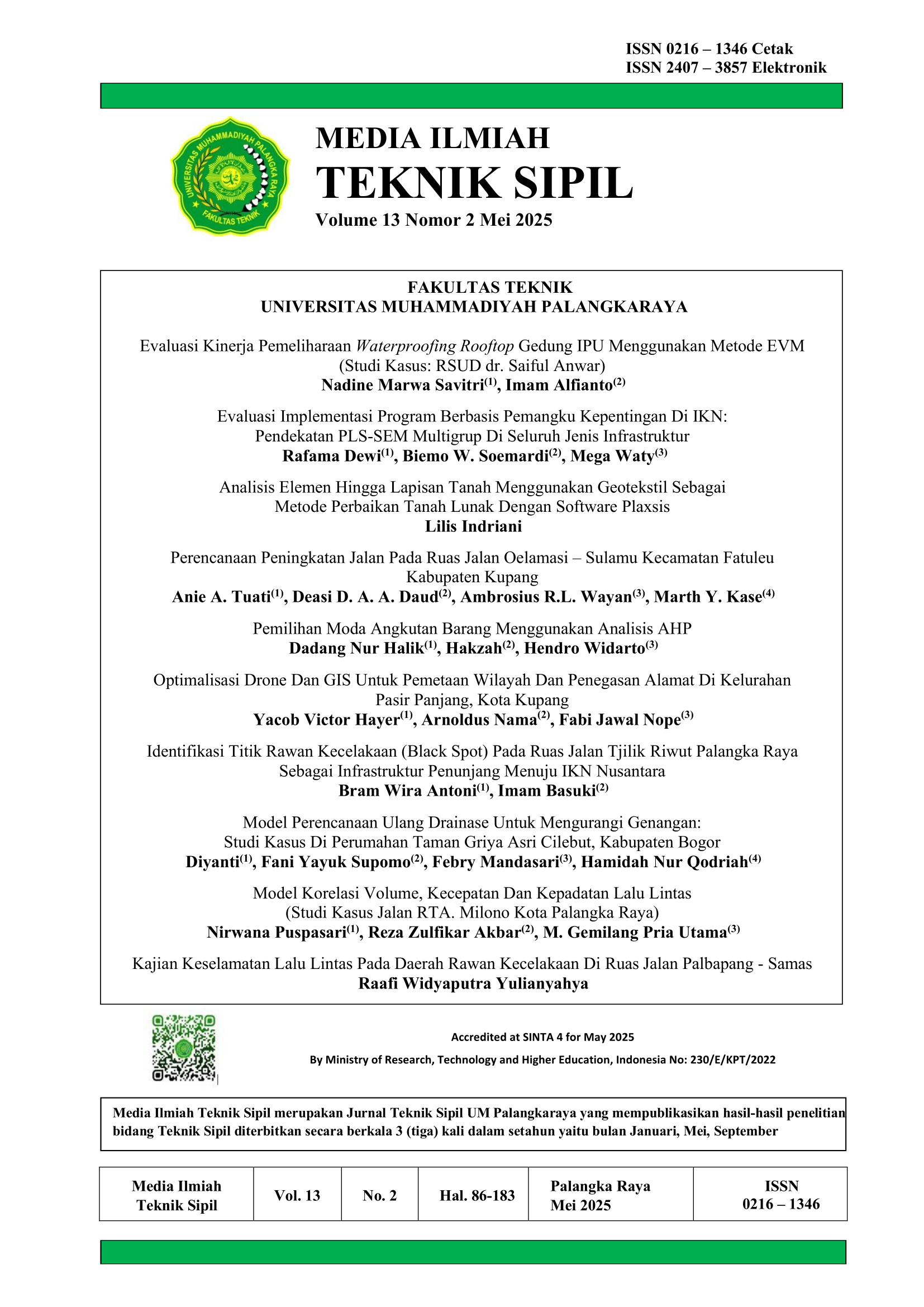Evaluasi Implementasi Program Berbasis Pemangku Kepentingan Di IKN: Pendekatan PLS-SEM Multigrup Di Seluruh Jenis Infrastruktur Stakeholder-Based Evaluation Of Program Implementation In IKN: A Multigroup PLS-SEM Approach Across Infrastructure Types
Main Article Content
Abstract
The implementation of program management in megaprojects often encounters a gap between strategic planning and field execution. This study evaluates stakeholder perceptions regarding the effectiveness of program implementation and project performance in Indonesia’s Nusantara Capital City (IKN). A quantitative survey was conducted with 200 respondents divided into two infrastructure typologies: Horizontal (roads, area development, water resources) and Vertical (high-rise and low-rise buildings). A 6-point Likert scale questionnaire measured six variables: benefit tracking (X1), resource allocation (X2), coordination (X3), risk management (X4), program implementation (M1), and project performance (Y1). The data were analyzed using Partial Least Squares Structural Equation Modeling (PLS-SEM) and multigroup analysis. In Horizontal projects, coordination emerged as the dominant factor (X3→M1 = 0.546; p = 0.000), with program implementation significantly affecting project performance (M1→Y1 = 0.413; p = 0.000). In Vertical projects, risk management was key (X4→M1 = 0.302; X4→Y1 = 0.412; p = 0.000). The strongest indirect effect was found in the coordination-to-performance path through program implementation (0.259; p = 0.000). R² values indicate strong predictive power for program implementation (Horizontal = 0.617; Vertical = 0.660) and project performance (Horizontal = 0.680; Vertical = 0.597). These findings highlight the importance of context-specific program governance strategies.
Downloads
Article Details

This work is licensed under a Creative Commons Attribution-ShareAlike 4.0 International License.
All rights reserved. This publication may be reproduced, stored in a retrieval system, or transmitted in any form or by any means, electronic, mechanical, photocopying, recording.
References
Aaltonen, K., & Kujala, J. (2016). Towards an improved understanding of project stakeholder landscapes. International journal of project management. https://doi.org/10.1016/j.ijproman.2016.08.009
Castelblanco, G., Fenoaltea, E. M., De Marco, A., Demagistris, P., Petruzzi, S., & Zeppegno, D. (2024). Combining Stakeholder and Risk Management: Multilayer Network Analysis for Complex Megaprojects. Journal of Construction Engineering and Management, 150(2), 1–12. https://doi.org/10.1061/jcemd4.coeng-13807
Davis, K. (2017). An empirical investigation into different stakeholder groups perception of project success. International Journal of Project Management, 35(4), 604–617. https://doi.org/10.1016/j.ijproman.2017.02.004
Floricel, S., Michela, J. L., & Piperca, S. (2016). Complexity, uncertainty-reduction strategies, and project performance. International Journal of Project Management, 34(7), 1360–1383. https://doi.org/10.1016/j.ijproman.2015.11.007
Geraldi, J., & Söderlund, J. (2018). Project studies: What it is, where it is going. International Journal of Project Management, 36(1), 55–70. https://doi.org/10.1016/j.ijproman.2017.06.004
Kusimo, H., Oyedele, L., Akinade, O., Oyedele, A., Abioye, S., Agboola, A., & Mohammed-Yakub, N. (2019). Optimisation of resource management in construction projects: a big data approach. World Journal of Science, Technology and Sustainable Development, 16(2), 82–93. https://doi.org/10.1108/WJSTSD-05-2018-0044
Locatelli, G., Mancini, M., & Romano, E. (2017). Project manager and systems engineer: A literature rich reflection on roles and responsibilities. International Journal of Project Organisation and Management, 9(3), 195–216. https://doi.org/10.1504/IJPOM.2017.087577
Martinsuo, M., & Hoverfält, P. (2018). Change program management: Toward a capability for managing value-oriented, integrated multi-project change in its context. International Journal of Project Management, 36(1), 134–146. https://doi.org/10.1016/j.ijproman.2017.04.018
Müller, R., Drouin, N., & Sankaran, S. (2019). Modeling Organizational Project Management. Project Management Journal, 50(4), 499–513. https://doi.org/10.1177/8756972819847876
Osei-Kyei, R., & Chan, A. P. C. (2017). Implementing public–private partnership (PPP) policy for public construction projects in Ghana: critical success factors and policy implications. International Journal of Construction Management, 17(2), 113–123. https://doi.org/10.1080/15623599.2016.1207865
Patanakul, P., Kwak, Y. H., Zwikael, O., & Liu, M. (2016). What impacts the performance of large-scale government projects? … journal of project management, 34(3), 452–466. https://doi.org/10.1016/j.ijproman.2015.12.001
PMI.org. (2024). The Standard for Program Management (5 ed.). Project Management Institute, Inc.
Serra, C. E. M., & Kunc, M. (2015). Benefits Realisation Management and its influence on project success and on the execution of business strategies. International Journal of Project Management, 33(1), 53–66. https://doi.org/10.1016/j.ijproman.2014.03.011
Stretton, A. (2020). Strategic initiatives, project / program management, and responsibilities for benefits realization. PM World Journal, IX(V, May), 1–21.
Syaban, A. S. N., & Appiah-Opoku, S. (2023). Building Indonesia’s new capital city: an in-depth analysis of prospects and challenges from current capital city of Jakarta to Kalimantan. Urban, Planning and Transport Research, 11(1). https://doi.org/10.1080/21650020.2023.2276415
Too, E. G., & Weaver, P. (2014). The management of project management: A conceptual framework for project governance. International Journal of Project Management, 32(8), 1382–1394. https://doi.org/10.1016/j.ijproman.2013.07.006
